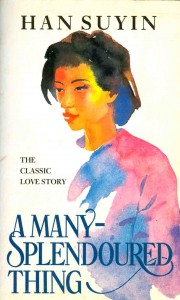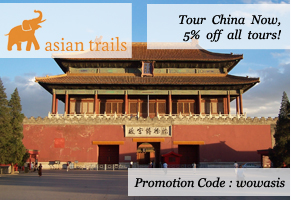 Han Suyin died in November of 2012 at the age of 95. Her book A Many-Splendored Thing, published in 1952, was the basis for the film starring William Holden and Jennifer Jones, and has influenced numerous writers. A recently written book, Janice Y.K. Lee’s The Piano Teacher, is probably one of those.
Han Suyin died in November of 2012 at the age of 95. Her book A Many-Splendored Thing, published in 1952, was the basis for the film starring William Holden and Jennifer Jones, and has influenced numerous writers. A recently written book, Janice Y.K. Lee’s The Piano Teacher, is probably one of those.
So we went scurrying back to re-read the book. She was a physician, and Han Suyin was the pen name of Elizabeth Comber, born Rosalie Matilda Kuanghu Chou. She was born in Xinyang, Henan, China. Her father was a Belgian-educated Chinese engineer, and her mother was Flemish.
The book takes place in Hong Kong, and is essentially a love story involving her eponymous doctor and Mark Elliott, an English journalist stationed in Asia. The two are buffed about by the changing political situation in mainland China and Elliott’s increasingly dangerous assignments in Asia, which ultimately determines his fate in Korea. Both Han and her heroine are Eurasians, and the attitudes among natives and expats alike toward mixed-race peoples are a fundamental underpinning of the book, as is the Communist takeover of China. While we find that the lovey-dovey prose gets to be a bit much, Han’s descriptive capabilities are extremely powerful, and among the best we’ve ever read. We highlighted many of them scattered throughout the book in a delicious pastiche of life in Hong Kong in the early 1950s. Her description of a Hong Kong dawn is superlative:
And yet there is a moment when night removes itself and day comes. But it is difficult to seize it: dawn, morning and day run into each other. The slight dawn breeze stirs faintly under the grey clouds heaped on the land and the sea, rasps some banana leaves, fingers the flames of the forest, sighs through the casuarinas. It sidles down into the harbour, prowls round the poised ships swathed in grey mist on a leaden sea. Towards the east, where the aircraft carrier anchored yesterday, a strip of lighter, paler grey widens slowly, turns white and opalescent like the belly of a fish. The ships are now clear, like pencil marks against the grey silk of the water. Land smoke from uplifted chimneys can be seen looping sluggishly skywards. Here walls, there a roof, the glimmer of a window alight. The aircraft carrier, a bristly black hedgehog, is now surrounded by a widening primrose patch, the sun. One moment all was grey and night-still, the next it is light, and in the hills the birds go mad. The light streaks the water with magenta, sweeps the mist away from the green hills, turns the ships black and red and white. The last cobweb cloud vanishes. Cars honk, boats hoot, ferries churn, trams ring wild bells, magpies call impatient names at each other, the cicadas tune up, and all is heat and toil, for day is here.
And can there ever have been a more senses-inspiring and delicious description of Chinese New Year:
Chinese New Year is the noisiest jollity of Hongkong. Weeks before the day, the shops, open till midnight or later, are crowded with people and crammed with monstrous arrays of food. Oranges and bananas, laichees, pears and apples and quince, carambolas and grapes, tangerines and persimmons, pummeloes, pineapples and mangoes; baskets smothered in paper roses embracing bottles of brandy, whisky, gin, vermouth, port, sherry, Cointreau, Kummel, Bols and Benedictine, wines and liqueurs from all over the world. Enormous ribboned boxes of chocolates from Switzerland, tins of shortbread and biscuits from England, cartons of candy and Kraft relishes from America; swag-bellied jars of candied orange peel, whole cumquats, pineapple chunks, ginger cubes, lotus buds, walnuts and almonds and coconut balls. Californian whole tinned chicken and Chinese dehydrated ducks flattened as waffles with billed heads looking out of their wicker envelopes; entire sucking pigs basted a delightful brown; speckled red and white sausages in bouquets hanging from shop ceilings; and the shouting which is the ordinary conversational tone of the Cantonese; and the perpetual click and slack of wooden slippers clattering on the stone pavements; and the blare of radios going full blast night and day on five thousand shop counters six feet from each other; and the cars honk-honk-honking their way through the packed streets; the houses gaudy with scarlet paper on doors and lintels and walls; the incense sticks smoking in handfuls at corner steps and under tables to the earth and hearth gods; the children gay in shiny bright satin clothes; the lovely sweet-scented enkianthus, bell flower of New Year, swaying in tall vases; and rows and rows of plum and early cherry blossom and narcissi at the Wantsai Flower Fair.
And the firecrackers — a threat to hearing and to health, to sleep and sanity. The law limits their cannonade to a bare forty-eight hours, during which Englishmen plug their ears with cotton wool, swallow sleeping tablets, and shun the streets. In unrelenting, soul-smashing, ear-pulverizing thunder, without stop during the light hours and the dark, the firecrackers sizzle, roar, pop, burst, whoop, smack, thud and bang; backfire behind and under cars; whizz from balconies and windows; salvo at street crossings, detonate under empty tins. Suspended from the roof of famous restaurants three storeys high, and reaching down to the tarmac road, they burst steadily for over half an hour at the modest cost of a thousand dollars every six minutes. The streets are rivers of red paper and cinders, everything smells of roast pork and gunpowder. With lunatic joy we hear so much money vanish in fire and sound, for thus a frugal race explodes in frenzied extravagance on ritual occasions: funerals, the birth of sons, and the New Year.
 Han’s prose explodes in consistently powerful descriptions throughout the book. These are but two, but there are dozens in this 322 page book, all delightful or sobering, for all is not well in the colony. She pulls few punches in indicting certain members of the expat and wealthy Chinese communities, but less so in her analysis of Chinese communists. Han’s own life was a fascinating story. A Many-Splendored Thing is autobiographical, but many more books could have been written on her storied life. The book stands well to the test of time, and today, 60 years later, remains a fascinating and timeless account of an Asian city-state in transition.
Han’s prose explodes in consistently powerful descriptions throughout the book. These are but two, but there are dozens in this 322 page book, all delightful or sobering, for all is not well in the colony. She pulls few punches in indicting certain members of the expat and wealthy Chinese communities, but less so in her analysis of Chinese communists. Han’s own life was a fascinating story. A Many-Splendored Thing is autobiographical, but many more books could have been written on her storied life. The book stands well to the test of time, and today, 60 years later, remains a fascinating and timeless account of an Asian city-state in transition.
Thanks for catching that, Dr. Burke. Correction made.
In the novel “A Many-Splendoured Thing” Han Suyin is described as a medical doctor and not as a nurse as you incorrectly state.